This guide aims to help you avoid opening Mimics by listing all tips and tricks I could think of.
Before we start…
So if you want to think your own strategies, I suggest you to play the game without using this guide.
Also, this guide doesn’t guarantee you will be able to open every non-mimic chest. There are times when there is not enough information to tell which chest is a mimic and which is not.
However the tricks you’ll see, do guarantee all chests you open are safe.
This guide is currently under development, so it’s possible I’ll add more thing in the future.
Glossary & Notes
Accusation: a sentence that says a group of chests are mimics.
Direct accusation: a sentence that says a specific chest is a mimic.
Mimics remaining: refers to the mimics that are still unidentified.
Math:
The letter ‘n’ is used to refer to a variable number. This way I can specify rules that apply for different cases. For example: If the rule says ‘there are n mimics…’, you have to replace n for the number of mimics in your puzzle.
Basic tricks
Condition: Two chests tell opposite sentences.
Conclusion: One must be a mimic and the other not.
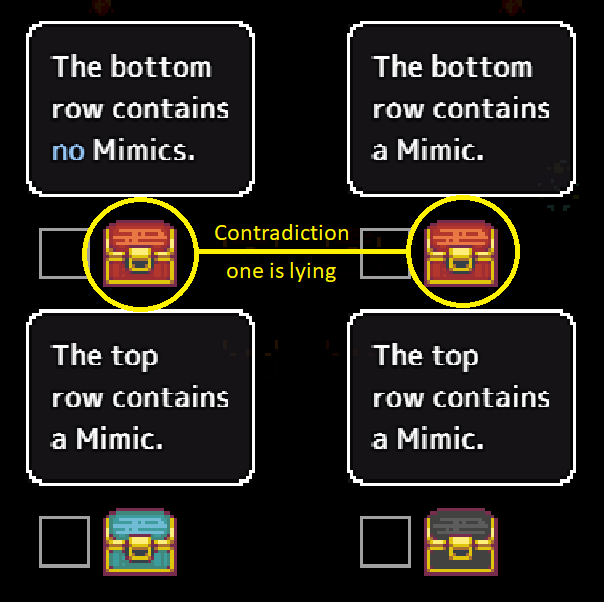
Condition: A chest directly accuses another chest of being a mimic.
Conclusion: One must be a mimic and the other not.
 Note: If the accusation is targeting a group, you can suspect there is at least one mimic among the involved chests (group + chest with accusation).
Note: If the accusation is targeting a group, you can suspect there is at least one mimic among the involved chests (group + chest with accusation).
Condition: A chest accuses a group and it belongs to that same group.
Conclusion: That chest isn’t a mimic.

Condition: Only one mimic remains and a chest validates another chest (or group of chests without containing known mimics).
Conclusion: Both the chest that validates and the validated chests are safe.
 Note: This trick is really useful to speed run floors with only one mimic.
Note: This trick is really useful to speed run floors with only one mimic.
Condition: n chests say the same and are less than n unidentified mimics.
Conclusion: The n chests are telling the truth.
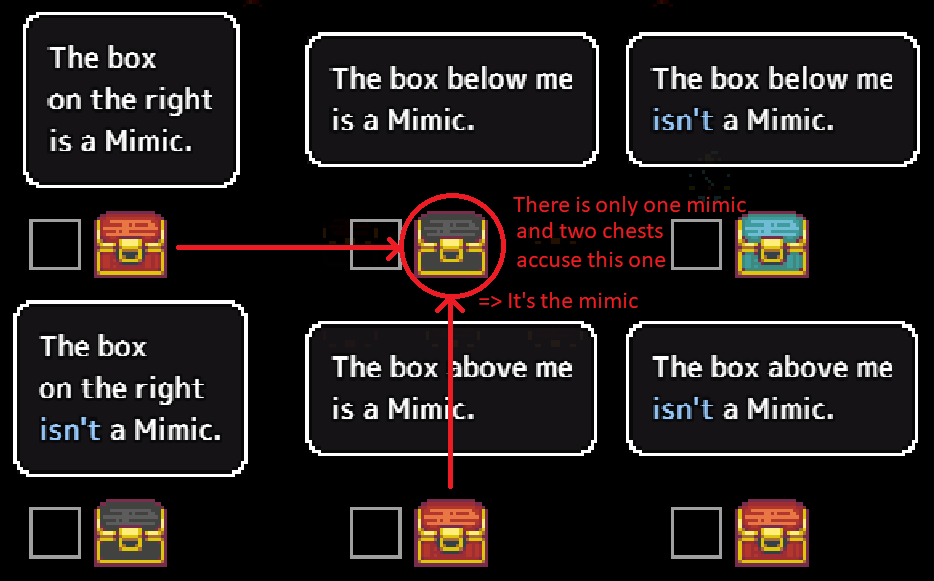
Condition: n mimics have to be identified and a chest is known to be a mimic.
Conclusion: The rest of the puzzle can be played as if there were n – 1 mimics.
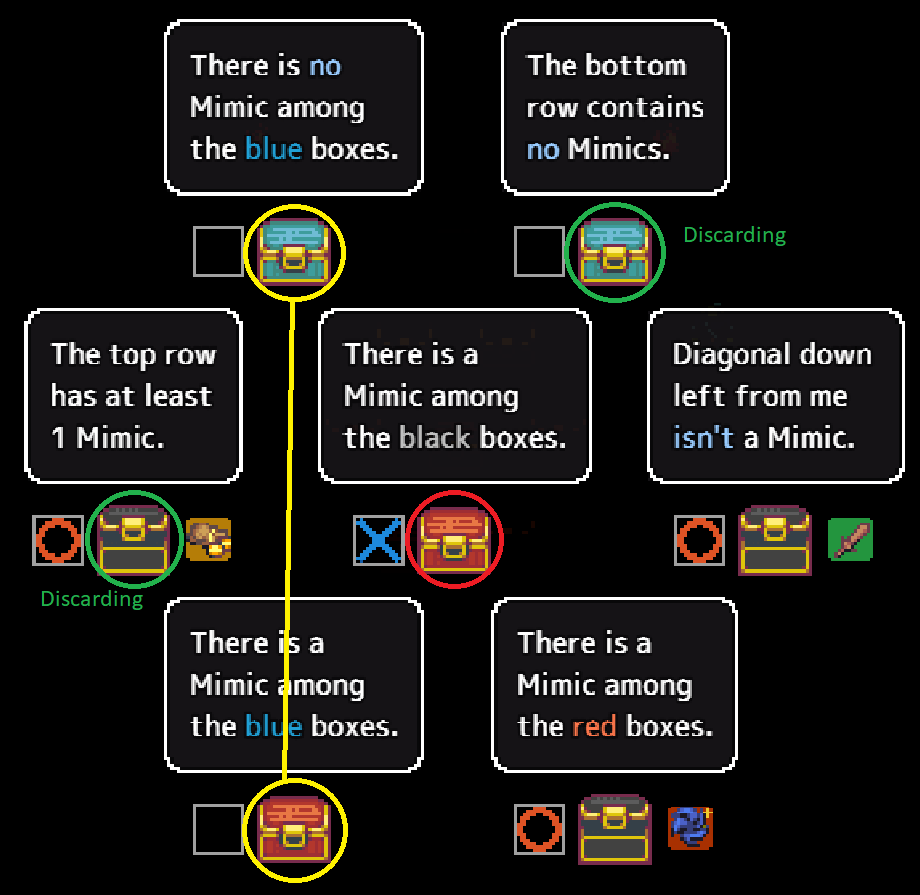 Note: In this picture the center chest is known to be a mimic, so the rest of the puzzle can be played as a 1 mimic puzzle. Since there is a contradiction, the remaining mimic is either the blue or the red chest. Thanks to that, I know the chests with green circles have no chance to be mimics.
Note: In this picture the center chest is known to be a mimic, so the rest of the puzzle can be played as a 1 mimic puzzle. Since there is a contradiction, the remaining mimic is either the blue or the red chest. Thanks to that, I know the chests with green circles have no chance to be mimics.
Condition: n mimics have to be identified and there is a contradiction between two chests.
Conclusion: The rest of the puzzle can be played as if there were n – 1 mimics remaining (without trusting anything related to the suspicious chests).
 Note: If the contradiction involves more than two chests, you must contemplate both possible cases and keep track of how many chests lie on each case. This way you can subtract the liars count to n. It can be a better idea to use the ‘Proof By Contradiction’ at this point.
Note: If the contradiction involves more than two chests, you must contemplate both possible cases and keep track of how many chests lie on each case. This way you can subtract the liars count to n. It can be a better idea to use the ‘Proof By Contradiction’ at this point.
Condition: There is a cycle of direct accusation between n chests.
Conclusion: The amount of mimics in the cycle are floor(n / 2) or ceil(n / 2).
Note: This condition rarely happens, and isn’t so useful.
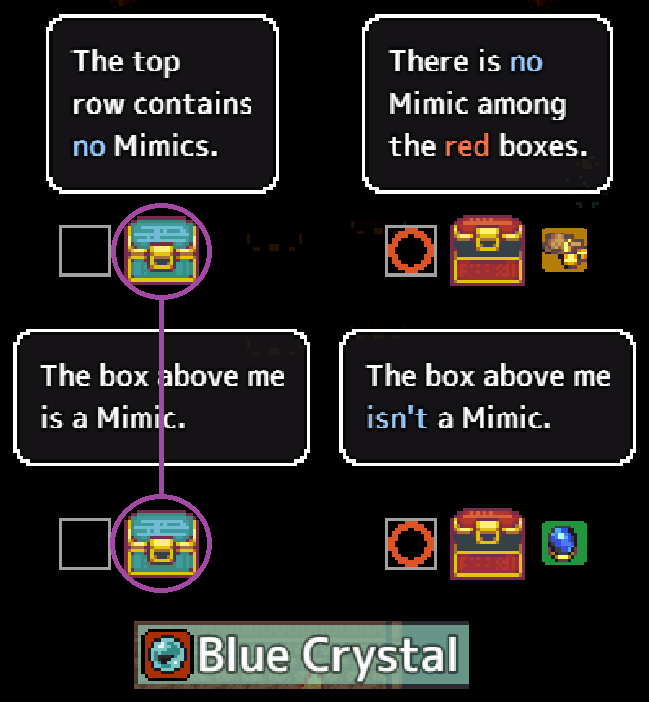 Sometimes there is not enough information to tell which chest is telling the truth and which one is lying. In this cases, it’s better to skip both chests. A ‘Blue Crystal’ can be used to find out which one isn’t a mimic, but in most cases this is not worth it.
Sometimes there is not enough information to tell which chest is telling the truth and which one is lying. In this cases, it’s better to skip both chests. A ‘Blue Crystal’ can be used to find out which one isn’t a mimic, but in most cases this is not worth it.
Strategies
You must count how many validations gets every chest (self-validations doesn’t count). I suggest you to use the right click to keep track of them.
“A chest is safe if its validation count is greater or equals to the amount of mimics remaining.”

This strategy uses multiple tricks. You can get more details of each trick in the ‘Basic tricks’ section.
- First look for any contradiction and mark them with numbers.
- Then look for accusations, and mark involved chests.
Now apply the ‘Discard’ trick.
If you managed to guarantee all mimics are among the suspected chest, those free of suspicion are safe. In the other hand, if there are still mimics outside of the suspected groups, then you can play the rest of the puzzle as if there were less mimics to find (ignoring the sentences related to the suspected chests)

You must count how many direct accusations gets every chest (self-accusations means that chest isn’t a mimic). You can use right click to keep track of them.
“A chest is mimic if its direct accusation count is greater than the amount of mimics remaining.”
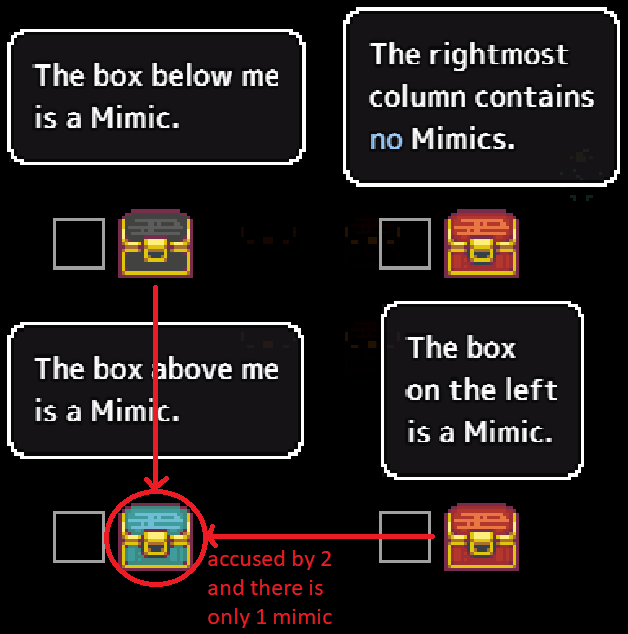 Note: This strategy uses Coincidence Trick, therefore all the chests that accused the mimic are safe.
Note: This strategy uses Coincidence Trick, therefore all the chests that accused the mimic are safe.
This strategy consists in assuming a chest is either telling the truth or lying and continue the puzzle with that hypothesis.
If doing that leads you to a contradiction, for example, getting more mimics than it should be or two ‘supposedly safe’ chests contradicting each other, then you know the assumption you did at the start was wrong.
But what happens if after the assumption everything goes well? Then you lost your time, nothing assures your assumption was correct. You have to undo everything you did after the assumption. This is why it should be used as a last resource.
Demostrations
Thanks to Mentally Challenged for their excellent guide; all credit belongs to their effort. If this guide helps you, please support and rate it here. Enjoy the game.
